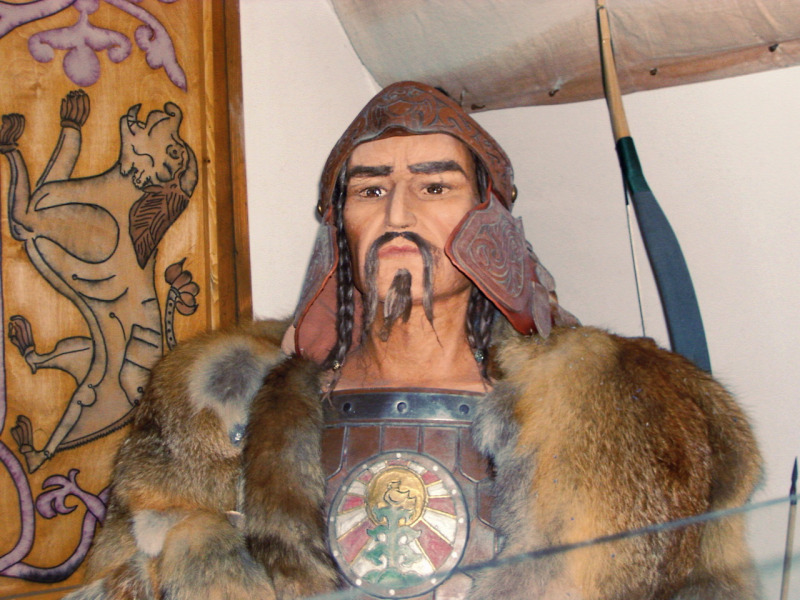Attila the Hun
Attila’s historical representation is most controversial in Western countries and Eastern cultures like Turkish or Hungarian. Actually, they are two parallel stories. One is the real historical version, the other is a colourful pool of legends and myths, the products of later centuries spiced with contemporary special effects. The latter is more interesting. Nevertheless, let’s stick first to the real Attila.
Attila the Hun
Source: WIKIMEDIA COMMONS
The real story starts with the nomadic Huns roaming from the steppe of Inner Asia and reaching the Carpathian basin in the early 5th century. They consolidated their power by making conquered tribes their loyal vassals. Like all nomadic invaders (including the Hungarian tribes arriving in the present territory in the 9th century) they had one sole objective: to maintain their superiority by raiding and looting, meanwhile keeping peoples in constant fear by their military skill and a style of fighting unknown to their enemies.
Born the child of Hun Chief Mundzuk in 406, Attila only came to power at the age of 28 when his father’s brother, King Ruga, died suddenly when he was struck by lightning. His elder brother Bleda inherited the title, but according to Hunnic tradition they shared power, at least until Bleda’s death in unknown circumstances in 445. Their eleven-year rule was a major blow for the Eastern Roman Empire. After rampaging in the Balkans, the Hunnic armies got as near as the fortified walls of Constantinople. They negotiated three peace agreements, as a consequence of which the Huns were well-supplied with gold and riches.
The dual kingship ended with Bleda’s death, when for the eight years that followed Attila assumed sole power over the Huns and their subordinated peoples. Of the two brothers Attila was more of a warrior type and also more ambitious. For further expansion he soon terminated the agreement made by his uncle Ruga with the Romans and started his long march to the western part of Europe, leaving no cities unharmed. At the peak of his rule the short-lived Hunnic Empire extended from the Baltic as far as the Atlantic. The devastation he brought to the west created the basis for his mythical image as “the scourge of God”. His unexpected death due to haemorrhage in 453 left the peoples of Europe in disarray. His three sons (Ellak, Denghizik and Ernak) were unable to hold the vast empire together, and in the absence of a charismatic leader like Attila the vassal tribes soon seceded. His appearance on the 5th c. European scene meant the last blow to the Latin Roman Empire, which came to an inglorious end, opening the way for the formation of western Christian nations.
This is the historians’ dry version of who Attila was and what role he played. More important is his mythical rebirth. Since authentic sources about his life are so scarce, his character is ideal for the creation of legends and myths. Western (German, French and Italian) popular literature portrays Attila as the epitome of Eastern barbarism, with dog’s ears, a cruel, merciless warrior, the arch enemy of anything civilized.
Hungarians on the contrary have their own story and it is deeply ingrained in our national consciousness due to literary works and those who ardently oppose the Finno-Ugrian theory concerning the origin of the Hungarians. Since Hungarians are obsessed with their ethnic geneology, especially the Asian links, there are innumerable camps of those who believe in the various theories, and it’s useless to argue with them. The circle of legends connected to the Huns and in particular to Attila is so wide and they are so much taken for granted that it would be equivalent to a betrayal of the nation to say that all these myths are just the products of the vivid imaginations of a few chronicle writers. To name just a few, here is a short list of the most common beliefs attached to Attila and the Huns.
Source: https://szentkoronaradio.com/blog/2020/12/04/hun-sirok-kinaban/

Attila the Hun by Eugene Delaroix
Source: http://www.eugenedelacroix.net/attila-the-hun/
- The Huns and the Hungarians are the same nation practically (never mind the 400 years between 460s when the Huns disappeared and 896 when Hungarian tribes under Chief Árpád conquered the Carpathian Basin). Some believers of the theory claim that Árpád is a direct blood descendant of Attila.
- Contrary to the western view Attila was a humane and wise ruler in the eyes of most Hungarians, even sparing Rome from destruction at the request of Pope Leo I.
- Not only is Attila a popular first name but most Hunnic characters have a domesticated Hungarian version, like Bleda is Buda, the city being named after him.
- The weirdest extreme you can reach in myth making is the case of Csaba, who is claimed by the Székely people living in Transylvania to be Attila’s son and thus the Székelys (Szeklers) are direct descendents of the Huns.
- Finally, it’s an ongoing national game to find Attila’s grave at the bottom of a river where he was buried in three coffins, one gold, one silver and one iron.
No matter what historians and western image distorters say, Attila is great, and he is ours, though the Turks may have some claim too (a lot of Turkish babies get Attila as their first name). Nevertheless, myth making on such a large scale has also a boomerang effect: people are punished for believing what they produced both in the West and the East. The figure of Attila will provide excellent ammunition for both Hollywood second-rate filmmakers and self-claimed researchers of our Asian roots for centuries to come.
You can read more of famous Hungarians in the author’s book available at AMAZON:

